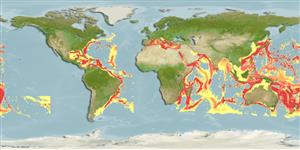Common names from other countries
Environment: milieu / climate zone / depth range / distribution range
Ecologia
; intervalo de profundidade 0 - 3890 m (Ref. 102521). Tropical
Circumglobal.
Length at first maturity / Tamanho / Peso / Idade
Maturity: Lm ? range ? - ? cm
Notable in tropical and subtropical coastal fouling communities (Ref. 102523). Found among living corals as well as on the underside of dead corals. Buried in the skeleton of Montastraea sp. while also seen attached to a dead Pocillopora damicornis (Ref. 102066). Filter feeds to extract minute plankton and organic matter from water column (Ref. 107862).
Life cycle and mating behavior
Maturidade | Reprodução | Desova | Ovos | Fecundidade | Larvas
Members of the class Polychaeta are gonochoric (sexual), gametes are spawned through the metanephridia or body wall rupturing.
Coles, S.L., R.C. DeFelice, L.G. Eldredge and J.T. Carlton. 1999. (Ref. 3356)
Status na Lista Vermelha da IUCN (Ref. 130435)
Status no CITES (Ref. 108899)
Not Evaluated
Not Evaluated
Uso pelos humanos
| FishSource |
Ferramentas
Mais informação
Idade/Tamanho
Crescimento
Comprimento-peso
Comprimento-comprimento
Morfologia
Larvas
Abundância
Fontes da internet
Estimates based on models
Preferred temperature
(Ref.
115969): 3 - 13, mean 4.8 (based on 2429 cells).
Categoria de preço
Unknown.
